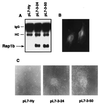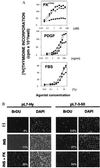Mitogenic and oncogenic properties of the small G protein Rap1b
- PMID: 9636174
- PMCID: PMC22655
- DOI: 10.1073/pnas.95.13.7475
Mitogenic and oncogenic properties of the small G protein Rap1b
Abstract
It has been widely reported that the small GTP-binding protein Rap1 has an anti-Ras and anti-mitogenic activity. Thus, it is generally accepted that a normal physiological role of Rap1 proteins is to antagonize Ras mitogenic signals, presumably by forming nonproductive complexes with proteins that are typically effectors or modulators of Ras. Rap1 is activated by signals that raise intracellular levels of cAMP, a molecule that has long been known to exert both inhibitory and stimulatory effects on cell growth. We have now tested the intriguing hypothesis that Rap1 could have mitogenic effects in systems in which cAMP stimulates cell proliferation. The result of experiments addressing this possibility revealed that Rap1 has full oncogenic potential. Expression of Rap1 in these cells results in a decreased doubling time, an increased saturation density, and an unusual anchorage-dependent morphological transformation. Most significantly, however, Rap1-expressing cells formed tumors when injected into nude mice. Thus, we propose that the view that holds Rap1 as an antimitogenic protein should be restricted and conclude that Rap1 is a conditional oncoprotein.
Figures




References
-
- Noda M. Biochem Biophys Acta. 1993;1155:97–109. - PubMed
-
- Boguski M S, McCormick F. Nature (London) 1993;366:643–654. - PubMed
-
- Nagata K, Itoh H, Katada T, Takenaka K, Ui M, Kaziro Y, Nozawa Y. J Biol Chem. 1989;264:17000–17005. - PubMed
-
- Kitayama H, Sugimoto Y, Matsuzaki T, Ikawa Y, Noda M. Cell. 1989;56:77–84. - PubMed
Publication types
MeSH terms
Substances
Grants and funding
LinkOut - more resources
Full Text Sources
Other Literature Sources

